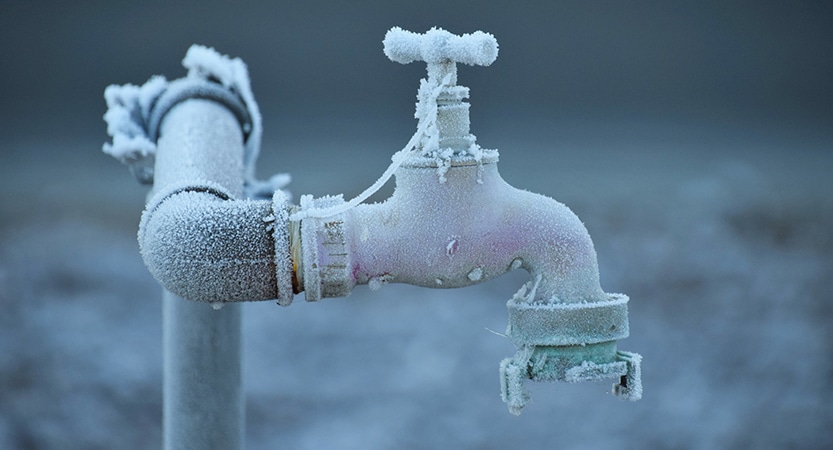They are making several great annotation on How to prepare your home plumbing for winter weather overall in this content directly below.

Winter can ruin your plumbing, particularly by freezing pipes. Below's just how to prevent it from happening and what to do if it does.
Introduction
As temperatures decline, the danger of icy pipelines boosts, potentially causing costly repair services and water damages. Recognizing just how to stop frozen pipelines is essential for homeowners in cold climates.
Comprehending Frozen Pipelines
What triggers pipelines to ice up?
Pipelines ice up when exposed to temperature levels below 32 ° F (0 ° C) for expanded periods. As water inside the pipes freezes, it increases, putting pressure on the pipeline walls and potentially causing them to break.
Risks and problems
Frozen pipelines can lead to water system interruptions, residential property damages, and expensive fixings. Burst pipelines can flood homes and trigger extensive structural damages.
Indications of Frozen Pipes
Determining icy pipelines early can avoid them from bursting.
Exactly how to determine frozen pipes
Try to find lowered water flow from taps, unusual smells or noises from pipes, and noticeable frost on revealed pipelines.
Prevention Tips
Insulating prone pipelines
Wrap pipes in insulation sleeves or use warmth tape to shield them from freezing temperatures. Focus on pipes in unheated or exterior locations of the home.
Home heating strategies
Maintain interior rooms adequately warmed, particularly locations with plumbing. Open up closet doors to allow warm air to distribute around pipes under sinks.
Safeguarding Outside Plumbing
Garden tubes and exterior taps
Detach and drain yard tubes prior to wintertime. Install frost-proof faucets or cover outdoor faucets with protected caps.
What to Do If Your Pipelines Freeze
Immediate activities to take
If you think frozen pipes, maintain faucets open to relieve pressure as the ice melts. Utilize a hairdryer or towels taken in warm water to thaw pipes slowly.
Long-Term Solutions
Structural modifications
Think about rerouting pipelines far from exterior wall surfaces or unheated areas. Include extra insulation to attic rooms, basements, and crawl spaces.
Updating insulation
Invest in high-quality insulation for pipelines, attic rooms, and walls. Proper insulation helps keep regular temperatures and lowers the risk of icy pipes.
Verdict
Stopping icy pipelines needs proactive steps and quick reactions. By comprehending the causes, indicators, and safety nets, home owners can protect their pipes throughout cold weather.
5 Ways to Prevent Frozen Pipes
Drain Outdoor Faucets and Disconnect Hoses
First, close the shut-off valve that controls the flow of water in the pipe to your outdoor faucet. Then, head outside to disconnect and drain your hose and open the outdoor faucet to allow the water to completely drain out of the line. Turn off the faucet when done. Finally, head back to the shut-off valve and drain the remaining water inside the pipe into a bucket or container. Additionally, if you have a home irrigation system, you should consider hiring an expert to clear the system of water each year.
Insulate Pipes
One of the best and most cost-effective methods for preventing frozen water pipes is to wrap your pipes with insulation. This is especially important for areas in your home that aren’t exposed to heat, such as an attic. We suggest using foam sleeves, which can typically be found at your local hardware store.
Keep Heat Running at 65
Your pipes are located inside your walls, and the temperature there is much colder than the rest of the house. To prevent your pipes from freezing, The Insurance Information Institute suggests that you keep your home heated to at least 65 degrees, even when traveling. You may want to invest in smart devices that can keep an eye on the temperature in your home while you’re away.
Leave Water Dripping
Moving water — even a small trickle — can prevent ice from forming inside your pipes. When freezing temps are imminent, start a drip of water from all faucets that serve exposed pipes. Leaving a few faucets running will also help relieve pressure inside the pipes and help prevent a rupture if the water inside freezes.
Open Cupboard Doors
Warm your kitchen and bathroom pipes by opening cupboards and vanities. You should also leave your interior doors ajar to help warm air circulate evenly throughout your home.

Do you enjoy reading up on Preventing and dealing with frozen pipes? Try leaving a short review directly below. We would be glad to see your ideas about this review. We are looking forward to see you back again soon. Do you know somebody who is occupied with the niche? Feel free to promote it. I am grateful for being here. Come back soon.
Free Estimates